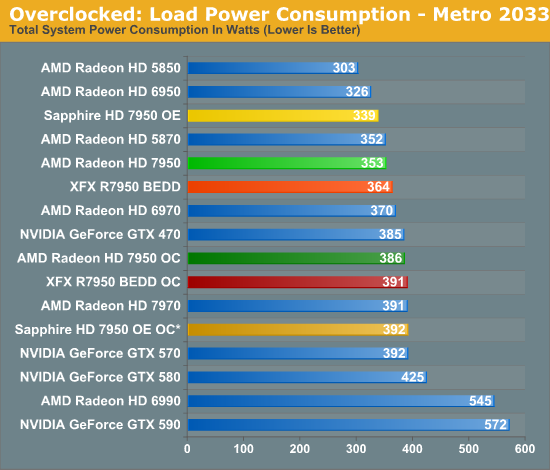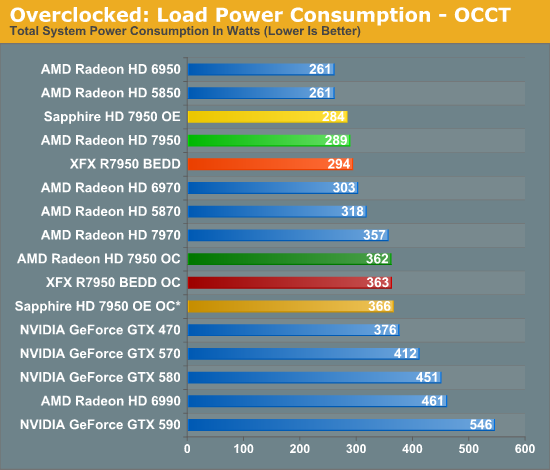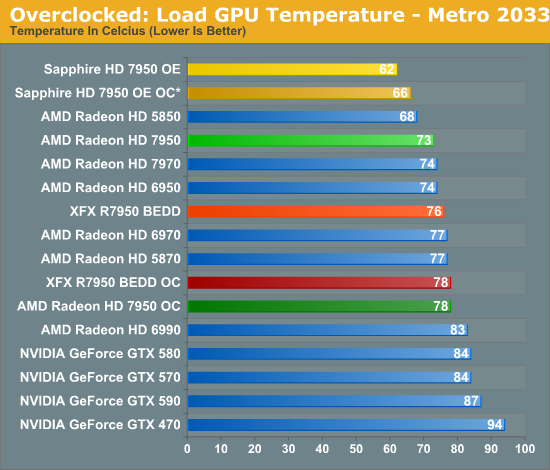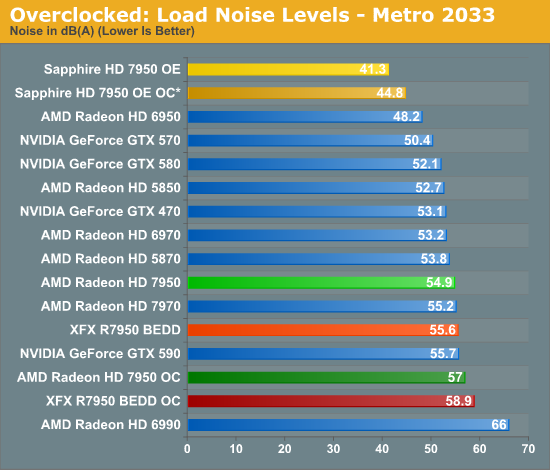AMD Radeon HD 7950 Review Feat. Sapphire & XFX: Sewing Up The High-End Market
by Ryan Smith on January 31, 2012 9:02 AM ESTOverclocking: Power, Temp, & Noise
In their marketing materials AMD is heavily pushing overclocking, and they have good reason to. With the 7970 we’ve established that Tahiti has quite a bit of overclocking headroom, and as the 7950 is clocked lower by default this opens up that headroom even further. Realistically AMD’s binning process means that the best clocking Tahiti GPUs are going to be allocated to the 7970 unless they have failed shaders, but even with that there’s quite a bit of potential on paper.
As with overclocking the 7970, our goal overclocking the 7950 is to see how much you can get for free; that is without any voltage adjustments. AMD’s reference PCBs are not particularly overbuilt for overclocking—cards like that will come later—so sticking to the reference voltage is the safest option, not to mention the easiest. With the 7970 we were able to get 200MHz (22%) overclocks without any voltage adjustment, and we’re hoping for the same out of the 7950.
With that said, we quickly ran into a wall on one card: the Sapphire 7950. Sapphire’s low VID of 0.993v may be great for temperature and noise at stock, but it’s not doing overclocking any favors. We only hit 950MHz at that voltage. As the Sapphire was the odd man out—every other card was at 1.093v—we did end up overvolting the Sapphire to 1.093v to see what it was capable of when put on similar footing as the rest of our cards.
After bringing up the voltage of our Sapphire card, all of our 7950s ended up overclocking to very similar levels. Our Sapphire and AMD cards topped out at 1025MHz core, a 225MHz (28%) overclock over a stock 7950 and a 125MHz (14%) overclock over the Sapphire’s factory overclock, while our XFX card reached 1050MHz, a 150MHz (17%) overclock beyond XFX’s factory overclock. Meanwhile the memory clocks on all of our cards topped out at 5.8GHz, beyond which we’d start seeing performance regressions from error correction on the memory bus.
| Radeon HD 7950 Overclocking | |||||
| AMD Radeon HD 7950 | Sapphire HD 7950 Overclock Edition | XFX R7950 BEDD | |||
| Shipping Core Clock | 800MHz | 900MHz | 900MHz | ||
| Shipping Memory Clock | 5GHz | 5GHz | 5.5GHz | ||
| Shipping Voltage | 1.093v | 0.993v | 1.093v | ||
| Overclock Core Clock | 1025MHz | 1025MHz | 1050MHz | ||
| Overclock Memory Clock | 5.8GHz | 5.8GHz | 5.8GHz | ||
| Overclock Voltage | 1.093v | 1.093v | 1.093v | ||
As you can imagine, with such similar overclocks, gaming performance on all 4 cards ended up being very similar. So we’ll get to gaming performance in a minute, while we’ll start with power, temperature, & noise.


Even though we’re not increasing the voltage on our AMD and XFX cards, merely overclocking them and raising the PowerTune limit to avoid throttling does drive the power consumption up. As is typical with heavily overclocked cards, overclocking quickly drives up power consumption and the 7950s are no exception. After overclocking power consumption is almost identical to the stock 7970, so while you can get 7970 performance you still need to pay the price with 7970 power consumption. Meanwhile it’s interesting to note that even with the extra 0.1v we’ve given the Sapphire card its final power consumption is only ever so slightly higher than the other 7950s, proving that voltage is the great equalizer in this case.


With the increase in power comes an increase in temperatures. The Sapphire card still does very well here staying in the low 70s even under OCCT, while the reference and XFX cards hit the high 70s under Metro and mid 80s under OCCT. As we’ve yet to really ascertain what the thermal limits are for Tahiti, it’s not clear whether there’s too much thermal headroom left for the GPU, particularly under OCCT.


Last but not least we have load noise. The Sapphire card is once more a stellar performer, and we still can’t get it above 50dB even with OCCT. Unfortunately the XFX 7950 BEDD has its biggest fallout yet—it may be able to overclock well, but at 64dB under OCCT the performance isn’t going to be worth the immense amount of noise it creates to move enough air to keep the GPU cool.










259 Comments
View All Comments
mak360 - Tuesday, January 31, 2012 - link
i would easily buy the HD7950 over the old tech - outdated - hot - power hungry - loud GTX580 junk. The HD7950 is same price, new tech, uses 72 watts less, is cooler, is silent, is 28nm, is faster, has compute, has pcie3, has x3 monitors, has audio over each channel, also slaps the 590 if thats what you want lol.its a win-win, you would have to be an idiot to buy anything nvidia has currently in the high end.
chizow - Wednesday, February 1, 2012 - link
Anyone interested in high-end already owns Nvidia and is hitting the snooze button on this launch until Kepler.There's only a 15-25% reason to buy a 7970, 0-5% reason to buy a 7950.
Death666Angel - Wednesday, February 1, 2012 - link
You keep repeating it, and you keep being wrong. There are a million reasons for someone to upgrade their system now. Maybe they got a better monitor for christmas and need the graphics card upgrade but waited a month until AMD revealed their new tech? Maybe it's someones birthday and he can get a big card. Or someone got a new job and wants a new card today? Not everyone who has the money and need for such a card now had it in the months before it.chizow - Wednesday, February 1, 2012 - link
In that case, they should probably wait for the real next-gen, since that's what most anyone was doing prior to the disappointing Tahiti reveal.Or go ahead and pick up a 6970/570 for much better price/performance return. Although we may actually see the prices go back up now that its obvious Tahiti did nothing to force downward pricing pressure.
yankeeDDL - Wednesday, February 1, 2012 - link
Just look at the review from Tomshardware.Based on performance, they were expecting the 7950 to be prices around $480. Then they were informed about the MSRP of $450 and took it extremely well.
Just sayin'
Spunjji - Wednesday, February 1, 2012 - link
Unfortunately you gave yourself away as a bit of an idiot as soon as you failed to address anything about the product other than its raw performance.Precisely what makes you think that AMD /has/ to price their products at this level? They have a smaller chip that performs better for less power. As soon as nVidia releases competing products they'll drop trou on the price and everyone can be happy. Right now they're price-gouging the performance-obsessed, just like nVidia have been for as long as they've had the top product.
Personally, I'm disappointed that they've abandoned the 3/4/5000 series approach of providing fantastic value for money, but apparently that wasn't earning them any money. Big shame, don't care, move on. I'll be waiting for Kepler to show before I make any buying decisions.
chizow - Wednesday, February 1, 2012 - link
If the only thing AMD is able to bring to the table from a full node process shrink is a reduction in power consumption, they've already failed.What compounds their failure however, is the fact they're trying to price this card that doesn't even significantly outperform last-gen parts at existing prices.
If they actually priced this where it should be ~$380-$400, it'd be a completely different story. Because they'd actually be offering you all of those fringe benefits you listed as well as either high-end performance at a much lower price OR significantly higher performance at the same price.
These are the kinds of metrics people look at when deciding to upgrade, or not. Pricing a product that performs the same as a part that's been available for 14 months already just doesn't make any sense, sorry.
ven - Thursday, February 2, 2012 - link
after all the conversation you have given i came to only one conclusion you all guys created as much hype for the kepler. Nvidia will be much delighted for this.after reading all these I would be not surprised if Nvidia print a link to these website page on their kepler card boxes as part of their advertisement.chizow - Thursday, February 2, 2012 - link
I don't think Nvidia cares about what's written here tbh, I don't think it took more than looking at the benchmarks for them to get excited.What they care about:
-AMD's top 28nm = only 15-25% faster than their last-gen top 40nm
-AMD's 2nd 28nm = only 0-5% faster than their last-gen top 40nm
The result is the rumors and indirect quotes attributed to Nvidia personnel at CES amounting to:
"We expected more from AMD's HD7900 series."
But really, this quote could and should be attributed to anyone, especially at the asking price. It seems most people feel this way, makes you wonder why AMD fans don't.
Galidou - Saturday, February 4, 2012 - link
it's fun to see comparison of parts only by the size of the transistor..... the thing is the 40nm parts from nvidia from last gen are BIG gpus, you gotta compare the quantity of transistor to transistor to understand the % increase in performance....AMD's smaller gpus smaller power enveloppe that maxes performance/die size vs Nvidia's maximum die size/max performance attainable with good yields...